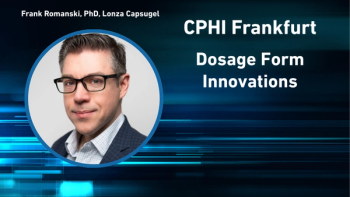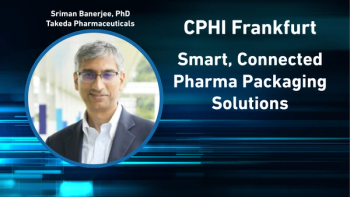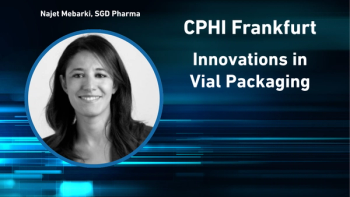
Pharmaceutical Technology Europe
- Pharmaceutical Technology Europe-05-01-2007
- Volume 19
- Issue 5
Developments in particle engineering processes for pharmaceutical drug delivery systems
One of the major concerns with introducing PAT, however, is that the bias towards process engineering may not ultimately lead to complete control of product quality.
Delivering medicines to the human body has always met with technological and physical challenges. Recent advances in powder and material processing and characterization methods allow formulators and engineers to design increasingly elaborate drug delivery systems. However, many obstacles need to be overcome to successfully develop and introduce these products.
The constant requirement for the targeted delivery of therapeutically active agents has been the key driver in particle engineering and processing within the pharmaceutical sector. These increasingly complex agents are posing greater challenges to formulators because of their solubility, stability and other physicochemical properties. Consequently, development projects tend to be designed based on an evaluation of current practices and, most importantly, the perceived challenges of introducing potential new particle processing technologies and the possible implications of the regulatory developments requirements; for example, The Framework for Innovative Pharmaceutical Manufacturing and Quality Assurance — process analytical technology (PAT) and The International Conference on Harmonisation of Technical Requirements or Registration of Pharmaceuticals for Human Use Quality 8 (ICH Q8).1,2
Evaluation of current practices
The common strategy for producing a pharmaceutical solid dosage form is based on a growth of scale; that is, the active pharmaceutical ingredient (API) molecule is engineered to a crystal form, which is then processed into particles and finally 'formulated' into the dosage form. The particle processing typically uses a destructive, energetic 'top-down' technique to reduce the API to the required particle size range for a particular dosage form.
These techniques, such as fluid air-jet milling, were introduced in the late 1930s and early 1940s and have been applied in a wide variety of industrial applications, including processing pigments and pesticides. Previously, only limited technological advances have been achieved for these processing techniques; for example, changes to the geometries of the milling chambers and product-feed units, and developments in particle filtration have led to an increase in productivity, product yield and specificity. This milling approach to particle engineering is energy-intensive, involves extravagant use of resources and time and, more critically, can adversely affect a whole range of highly important material physicochemical properties, which may have significant effects on product stability and clinical performance.
Key points
While there is an ever-increasing need to address these issues, the industry generally remains reluctant to embrace new particle engineering technologies, and their development for scale-up processing of APIs and excipients. The perceived resistance may relate to the risk-adverse culture that has developed within the highly regulated pharmaceutical manufacturing sector and, moreover, within the product development groups. This is in complete contrast with drug discovery where innovation is encouraged. The validation-based approach to pharmaceutical processing and manufacturing has not only stifled innovation, but also the motivation to improve product development and manufacturing efficiency. Other factors that have limited the introduction of new particle engineering technologies include the costs of implementation, support and the required equipment. Thus, novel particle engineering technologies have remained limited to extending product life cycles, and where conventional particle technologies are unable to produce the physicochemical properties and/or stability required for a particular dosage form.
Regulatory drivers
The welcome introduction of regulatory guidance such as PAT, ICH Q8 and the proposed ICH Q9 will manoeuvre the industry towards a more scientific- and engineering-based relationship with their materials and processes involved in pharmaceutical product development and manufacturing and, importantly, their effect on product quality. Their implementation may not only overcome some of the constraints the industry has been subjected to over the years, but also provide the impetus and opportunity for the continuous development of product quality by the design and development of material processing technologies.
One of the major concerns with introducing PAT, however, is that the bias towards process engineering may not ultimately lead to complete control of product quality. While the focus towards improved understanding of the process parameters of unit operations (e.g., temperature, spectroscopic analysis and moisture content) will lead to the development of high-tech process control technologies, it is inevitable that, for a significant number of applications, the traditional methods for preparing, and the specific functionality of APIs and excipients will become the critical component of product quality and performance.
Thus, while all the critical sources of variability may be identified using a guidance-led approach, the variables may be on a scale that cannot be controlled by current practices in particle engineering, processing and characterization. The development and shift away from understanding processing parameters of unit operations towards a more tailored approach regarding specific functionality and product properties using particle engineering and formulation technologies, has already occurred within the chemical engineering sector.
The industry must, therefore, make a concerted effort to understand product engineering through a greater realization and control of product properties and process attributes. Importantly, as ICH Q8 states that "quality cannot be tested into products, i.e., quality should be built in by design", it is vital that any relationships between processing operations, product components and product quality should be understood. This research may provide pharmaceutical companies with a greater competitive edge and protect future drug products from generic competition as they may be unable to match product performance and therapeutic efficacy.
Recent technological developments
It is important to state that while novel particle processing technologies have had limited success, alternative approaches have been used to enable effective drug delivery to the body. For example, polymorphic engineering of APIs can be successfully used to impart a specific drug property offering improvements in, for example, solubility and stability. Additionally, excipient manufacturers have produced a range of products that can modify the formulation, processing and delivery of APIs through elaborate excipient material and particle engineering.
Control release excipients can target specific parts of the gastrointestinal tract (GIT) and materials, such as cyclodextrins, can be used to address solubility issues. However, even though these increasingly elaborate products have created and continue to introduce tremendous possibilities for drug delivery, they achieve this through secondary particle engineering; that is, the API is postprocessed. The challenge is to produce APIs and technologies where the properties are simply engineered to a specific use rather than rely on secondary materials for formulation, processing and efficacy.
Successful implementation of such an approach requires the introduction of a series of technological advances in particle engineering and material processing. Nektar (San Carlos, CA, USA) developed a dry powder insulin product called Exubera by processing insulin with selected excipients for drug delivery via the lungs. It has successfully developed and scaled-up the processing of macromolecules using its proprietary high glass transition (Tg) glass stabilization technology, which is based on controlling and manipulating the properties of a mixture of excipients.3 This spray drying-based technology has overcome the traditional stability problems (e.g., aggregation, deamidation and oxidation) typically associated with proteins and peptides under storage at room temperature through using glassy sugars to protect the fragile macromolecules from denaturation.
The success of this technological advancement has not only been in the particle engineering and its scale-up, but also in powder handling, where accurate and reproducible blister filling of 1–5 mg has been achieved under humidity protection.4 The triumph in overcoming the numerous technical and scientific hurdles may provide Nektar and its partners with a long-term competitive advantage in the dry powder inhaler delivery market of insulin and other macromolecules, possibly well beyond the patent lifetime of the developed technologies.
Conversely, the disposal of Nektar's supercritical fluid (SCF) particle engineering technology and the closure of its UK operation has highlighted the significant issues relating to the successful scale-up of novel particle engineering systems even when they are in their advanced stage of development and commercialization. It was deemed that the SCF platform technology would not produce products that fitted with their future business strategy.
Another novel approach is the particle engineering of biomolecules using protein-coated microcrystals (PCMCs). The formulation and stabilization technology of proteins, nucleic acids and vaccines by the coprecipitation of a water-soluble carrier, such as amino acid or carbohydrate, with a dehydrated biological macromolecule, makes them highly suitable for delivering biomolecules by a number of routes, including pulmonary and parenteral administration.5 XtalBio's PCMC technology (Glasgow, UK) and Boehringer Ingelheim has highlighted the potential of this new formulation and delivery systems for biological entities.
The future of particle engineering
One of the ongoing challenges for the formulation and preclinical evaluation of new chemical entities (NCEs) is that a significant number of lead candidates from drug discovery and high-throughput screening exhibit poor solubility. With the increasingly lipohphilic nature of the candidate drugs, solubility and dissolution rates have become the limiting factors that affect bioavailability of oral and parenteral formulations. While advanced technologies for enhancing delivery of poorly soluble drugs have included using polymorphic engineering, solid-dispersions, microemulsions, self-emulsifying systems, complexation and liposomes, a truly particle engineering-based solution remains particularly desirable to the pharmaceutical industry. The key advantages for developing such systems are the tailoring of the drug to the delivery requirements; the use of conventional processing and formulation; and that any safety issues regarding intravenous preparations, and the use of cosolvents and excipients may be overcome.
Another approach to enhance drug dissolution rates for drug targeting purposes is the processing of nanoscale drug particulates; the nanoscale being defined as 100 nm down to the size of atoms (~0.2 nm). However, while 'true' nanoparticles may not have yet been incorporated into pharmaceutical dosage forms, submicron-sized particles have been successfully used to improve the rate of dissolution and bioavailability of poorly soluble drugs. Elan's NanoCrystal technology (Athlone, Ireland) has been applied to optimize the performance of established drugs and as an enabling technology for NCEs.6 Here, drug particles less than 1 μm are produced by a wet-milling technique. The low-energy ball-milling process takes a relatively long time (a minimum of 4-5 days) to produce a suitable aqueous colloidal dispersion of the ultrafine particles containing an appropriate surfactant to stabilize the particles against agglomeration and degradation.
More recent research developments in engineering pharmaceutical nanosized drug particles have been based on a 'bottom-up' approach, either by a droplet formation and evaporation approach, a solvent precipitation method or a combination.
Droplet evaporation methods
A novel approach has been developed to produce dry drug particles by controlled droplet evaporation of nanosized droplets of a drug solution in an aerosol flow reactor.7 The continuous, single-step operation produces nanosized particles with narrow particle size distributions. The main issue to overcome with this approach is the scalability of the flow reactor for pilot and industrial commercialization, and the active control of the solid-state properties; for example, crystallinity of the particles during solvent evaporation.
Spray freeze-drying technologies have also been developed for creating nanostructured drug particles. The drug, which is dissolved in a water-miscible solvent together with a crystal growth inhibitor, is actively dispersed into a freezing medium, such as liquid nitrogen, followed by solvent removal by lyophilization.8 The resultant particles are agglomerated and highly porous with a yield of almost 100%. The process is expensive because it requires cryogenic technology, and the control of precipitation depends on the rate of solvent removal with the drying process.
Solvent precipitation methods
A recent modification of the conventional supercritical antisolvent approach has led to an enhanced mass transfer between the solvent and antisolvent, and the reduction of the particle size to submicron size range by the application of an ultrasonic field. The cogeneration of smaller droplets and increased turbulence, and mixing solvent droplets within the supercritical CO2 phase is generated by targeting a jet of the solution at a well-defined angle on to an ultrasonic horn oscillating at 20 Hz.9 The supercritical antisolvent with enhanced mass transfer (SAS–EM) is, however, limited by the scalability of the supercritical rig, the relatively slow solution transfer rate through the 75 μm capillary and the broad product particle size distributions.
A novel precipitation method for controlling the nucleation and crystallization of nanosized drug particles involves using high-gravity micromixing.10 High-gravity is formed using a rotating packed bed (15–50 Hz), which intensifies the mixing between multiphase systems inducing nucleation and crystal growth. The reactive precipitation mode has been successfully used in mineral processing at a commercial production scale (10000 tonnes/annum) and can control the particle size distribution by altering the rotating speed, solution concentrations or flow rates.
A unique particle engineering technology incorporating a combination of droplet evaporation and antisolvent crystallization by a sonication process known as solution atomization and crystallization by sonication (SAX [Prosonix; Oxford, UK]), which has been developed to produce nanoparticles within a well-defined particle size range while manipulating the nucleation and crystal growth process within the supersaturated droplets.11 The SAX technology has shown significant benefits in the modification and control of the macroscopic morphology, and surface topography of the crystalline nanoparticles, which, because of the dominant nature of the surface forces, play a critical role in the characteristic properties of nanoparticles.
Conclusions
With the obvious potential of nanoparticles in pharmaceutical delivery systems it can be anticipated that particle engineering technology needs to undergo considerable growth and advances over the coming years. Additionally, there is a further requirement for the industry to develop new high-tech scalable processes that are capable of handling these materials, and ensuring that the inability to formulate and manufacture these products is not the bottleneck for their application in pharmaceutical products.12 Considering that the current level of development of pharmaceutical particle technologies is relatively limited, and the understanding of the relationships between such materials and processes in the development and manufacturing of pharmaceutical products is at an early stage, there remains an onerous path for the successful development and implementation of particle-based technologies in the pharmaceutical industry.?
Robert Price is a reader at the Department of Pharmacology and Pharmacology, University of Bath (UK), where he leads the pharmaceutical surface science research group.
Stephen Edge is a visiting scientist, also at the Pharmaceutical Surface Science Group, University of Bath (UK).
References
1. Guidance for Industry PAT — A Framework for Innovative Pharmaceutical Development, Manufacturing, and Quality Assurance, Food and Drug Administration (September 2004).
2. http://
3. J.S. Patton, L. Foster and R.M. Platz, "Methods and compositions for pulmonary delivery of insulin," US 5,997,848 (1997).
4. S. White et al., Diabetes Tech. & Therapeutics,7, 896–906 (2005).
5. B.D. Moore, M.C. Parker and P.J. Halling, "Rapid dehydration of proteins," WO0069887 (2000).
6. H.W. Bosch et al., "Process for preparing therapeutic compositions containing nanoparticles," US 5,510,118 (1996).
7. E. Watanabe et al., "Method for the preparation of nanoparticles," US2004/0091542 (2004).
8. T.L. Rogers et al., Int. J. Pharm.,242, 93–100 (2002).
9. R.B. Gupta and P. Chattopadhyay, "Method of forming nanoparticles and microparticles of controllable size using supercritical fluids and ultrasound," US60/206,644 (2000).
10. J.F. Chen et al., Ind. Eng, Chem. Res., 39, 948–954 (2000).
11. J.S. Kaerger and R. Price, Pharmaceutical Research,21, 372–381 (2004).
12. F.J. Muzzio, T. Shinbrot and B.J. Glasser, Powder Technology,124, 1–7 (2002).
Articles in this issue
over 18 years ago
Polymers for CNS drug deliveryover 18 years ago
Making drug production pain-freeover 18 years ago
Optimizing bioconjugation processesover 18 years ago
Stable partnersover 18 years ago
Scotland the braveover 18 years ago
Outsourcing in Pharmaover 18 years ago
Greener, cleaner and leanerNewsletter
Get the essential updates shaping the future of pharma manufacturing and compliance—subscribe today to Pharmaceutical Technology and never miss a breakthrough.





